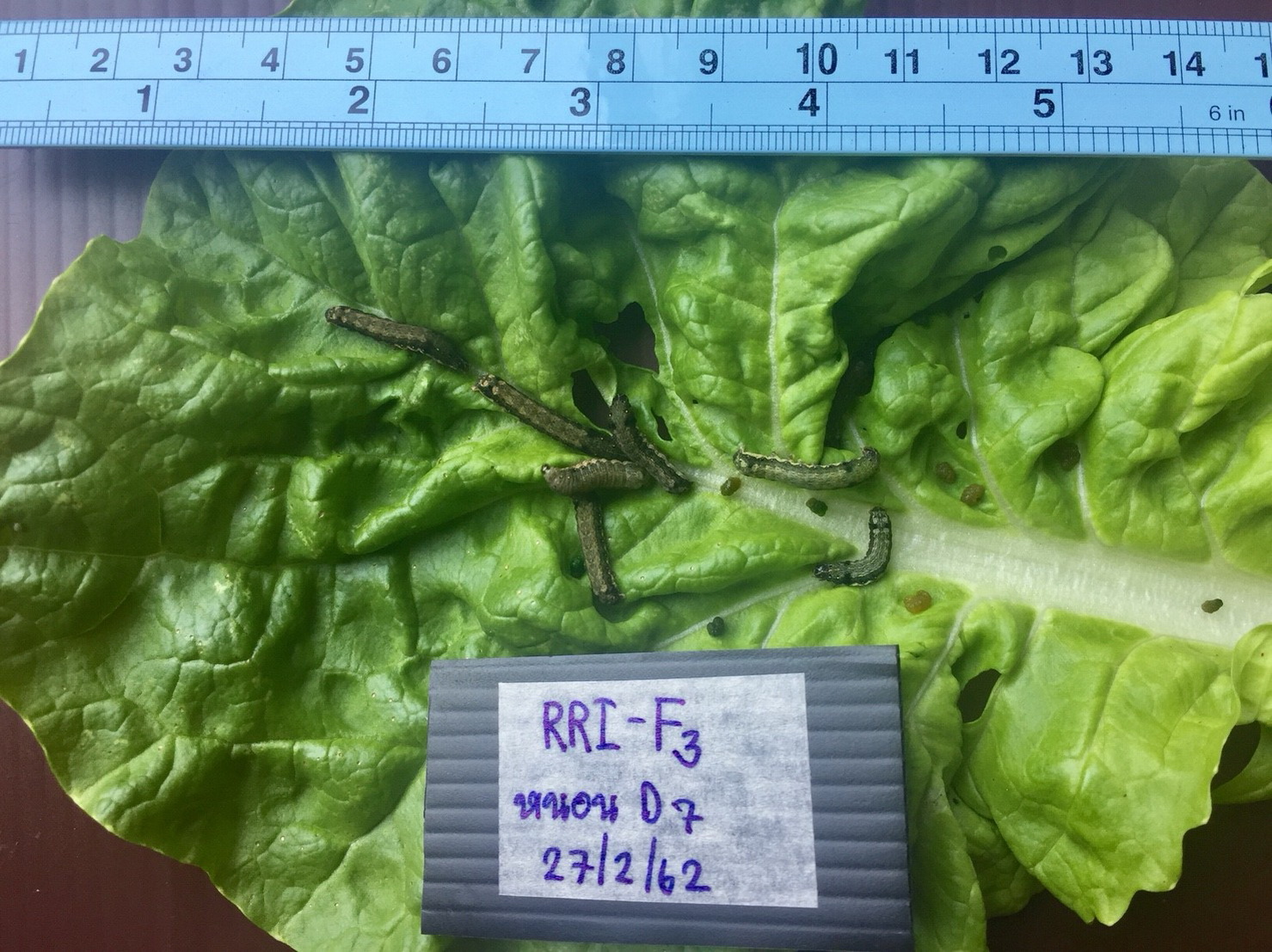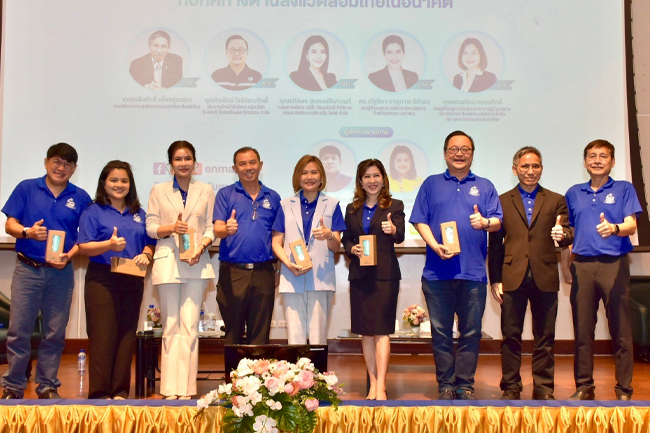Project Title: Efficacy development of insect repellent from Chromolaena odorata and Vernonia cinereal (L.) extracts for bio-control of Plutella xylostella L. in green vegetable cultivation
Research Title: Insect repellent from Chromolaena odorata and Vernonia cinereal (L.) extracts for bio-control in green vegetable cultivation
Researcher(s): Ms. Ladda Saengon; Assoc.Prof.Dr. Sayam Aroonsrimorakot; Asst.Prof.Dr. Preeyaporn Koedrith; Asst.Prof.Dr. Panupong Puttarak; Asst.Prof.Dr. Ammorn Insung
Affiliation: Faculty of Environment and Resource Studies, Mahidol University


Research Details (In Brief):
This research aimed at developing Thai herbal weeds in controlling pest insect with use of bioactive natural compounds in environmentally- and consumer-friendly manner. We also wish to develop innovative pest management in agricultural area or pest control products prototype with integrative appropriate biotechnology. Herein, we assessed efficacy of crude extracts of Chromolaena odorata (Siam weed) and Vernonia cinerea (L.) (Little ironweed) using 95% EtOH soaking, EM, and organic solvents (EtOH, EtOAc, and Hexane) in controlling 2nd larvae of Spodoptera litura (Fabricius) by leaf-dipping test for 24, 48, and 72 hours. At 48 hours Siam weed crude extracts using soaking at 5% (w/w) showed maximum accumulative lethality at 100%, its extracts using EM at 3.33% exhibited maximum accumulative lethality at 85%, and its extracts using Hexane at 5 mg/ml had maximum accumulative lethality at 95% while EtOAc- and EtOH-based extracts had lower maximum accumulative lethality (70% and 60%, respectively). Interestingly, Little ironweed crude extracts using soaking at all tested concentrations (5.0, 12.5 and 25.0% w/w) displayed maximum accumulative lethality at 100%, its extracts using EtOH (at 0.01, 0.1, 1.0 and 5.0 mg/ml) showed also maximum accumulative lethality at 100%, and its extracts using EtOAc and Hexane at 5 mg/ml had slightly lower (80%) maximum accumulative lethality. Importantly, at 72 hours both of Thai weed crude extracts using soaking, EM, and all tested organic solvents at most of tested concentrations exhibited maximum accumulative lethality at 100%. Our results demonstrated that at 72 hours both of Thai weed crude extracts using soaking and EM could effectively kill 2nd larvae of common cutworm at 100% lethality, as comparable to their crude extracts using tested organic solvents. This indicated good trend with use of both Thai weed extracts for controlling the pest insect in further semi-field study, compared to commercial herbal product and chemical insecticide.
Award Grant Related to the Project : This study was supported by research grant funded by Agricultural Research Development Agency (Public Organization) (ARDA).
Key Contact Person: Asst.Prof.Dr. Preeyaporn Koedrith; +66(0)2441500 ext 1224; This email address is being protected from spambots. You need JavaScript enabled to view it.



ชื่อโครงการวิจัย: การพัฒนาประสิทธิภาพสารไล่แมลงจากสารสกัดจากสาบเสือ และหญ้าดอกขาว เพื่อควบคุมหนอนใยผักแบบชีววิถี ในการปลูกผักกินใบ
ชื่อผลงานวิจัย: สารสกัดธรรมชาติไล่แมลงจากพืชสมุนไพรไทยสาบเสือ และหญ้าดอกขาว เพื่อควบคุมศัตรูในผักกินใบแบบชีววิถี
ชื่อผู้วิจัย: นางสาวลัดดา เสียงอ่อน รศ.ดร. สยาม อรุณศรีมรกต ผศ.ดร. ปรียาพร เกิดฤทธิ์ ผศ.ดร. ภาณุพงศ์ พุทธรักษ์ ผศ.ดร. อำมร อินทร์สังข์
ส่วนงาน: คณะสิ่งแวดล้อมและทรัพยากรศาสตร์ มหาวิทยาลัยมหิดล
รายละเอียดผลงานวิจัย (โดยย่อ):
งานวิจัยนี้มุ่งหมายพัฒนาสมุนไพรที่หาได้ง่ายมาประยุกต์ในการควบคุมศัตรูพืช ซึ่งอาศัยสารออกฤทธิ์ทางชีวภาพจากธรรมชาติ เป็นมิตรต่อสิ่งแวดล้อม และปลอดภัยต่อผู้ใช้และผู้บริโภค ทั้งนี้ยังมุ่งหวังสู่การต่อยอดในเชิงนวัตกรรมการจัดการป้องกันศัตรูพืชในพื้นที่เกษตรกรรม หรือพัฒนาผลิตภัณฑ์ยับยั้งศัตรูพืชต้นแบบ ซึ่งเป็นการบูรณาการร่วมกับเทคโนโลยีชีวภาพที่เหมาะสม การศึกษาฤทธิ์และประสิทธิภาพของสารสกัดจากสมุนไพรไทย 2 ชนิด คือ สาบเสือ และหญ้าดอกขาว ที่ผ่านการสกัดด้วย 3 วิธีหลัก คือ การแช่ยุ่ยด้วย 95% แอลกอฮอล์ การหมักด้วยอีเอ็มและการสกัดด้วยสารละลายอินทรีย์ (Ethanol Ethyl Acetate และHexane) ในการควบคุมหนอนกระทู้ผัก ระยะ 2 ด้วยวิธีจุ่มใบ พบว่าที่ 48 ชั่วโมง สารสกัดสาบเสือด้วยการแช่ยุ่ย ที่ความเข้มข้น 5% (w/w) ซึ่งเป็นความเข้มข้นต่ำสุดที่ศึกษา ทำให้หนอนตามสะสมสูงสุด 100% สารสกัดสาบเสือด้วยการหมักอีเอ็ม ที่ความเข้มข้น 3.33% ทำให้หนอนตายสะสมสูงสุด 85% และสารสกัดสาบเสือด้วยสารละลาย Hexane ที่ความเข้มข้น 0.001 1.0 และ 5.0 มก./มล. ทำให้หนอนตายสะสม 75% 85% และ 95% ตามลำดับ ขณะที่สารสกัดดังกล่าวด้วยสารละลาย EtOAc ที่ความเข้มข้น 5.0 มก./มล. ทำให้หนอนตายสะสมสูงสุด 70% และสารสกัดด้วย EtOH ที่ความเข้มข้น 0.001 และ 1.0 มก./มล. ทำให้หนอนตายสะสมสูงสุด 60% สำหรับสารสกัดจากหญ้าดอกขาวด้วยการแช่ยุ่ย ที่ทุกความเข้มข้นที่ศึกษา (5.0 12.5 และ 25.0%) ทำให้หนอนตายสะสม 100% สารสกัดหญ้าดอกขาวด้วยการหมักอีเอ็ม ที่ความเข้มข้น 16.5% (w/w) ทำให้หนอนตายสะสม 65% และสารสกัดหญ้าดอกขาวด้วยสารละลาย EtOH ที่ความเข้มข้น 0.01 0.1 1.0 5.0 มก./มล. ทำให้หนอนตายสะสมสูงสุด 100% และที่ความเข้มข้น 0.001 มก./มล. ทำให้หนอนตายสะสม 75% ขณะที่สารสกัดดังกล่าวด้วยสารละลาย Hexane และ EtOAc ที่ความเข้มข้น 5.0 มก./มล. ทำให้หนอนตายสะสมสูงสุด 80% และที่ 72 ชั่วโมง พบว่า สารสกัดสมุนไพรทั้งสองชนิด ด้วยการแช่ยุ่ย การหมักด้วยอีเอ็ม และสารละลายอินทรีย์ทั้งสามชนิด ที่ความเข้มข้นที่ศึกษาส่วนใหญ่ ทำให้หนอนตายสะสมสูงสุด 100 % จากผลการทดสอบประสิทธิภาพในการฆ่าหนอนเป้าหมายในระดับห้องปฏิบัติการ สรุปได้ว่า ที่ 72 ชั่วโมง สารสกัดสมุนไพรทั้งสองชนิดด้วยวิธีการแช่ยุ่ย และการหมักด้วยอีเอ็ม ให้ผลดี ฆ่าหนอนได้ 100% เทียบเคียงกับผลของสารสกัดด้วยสารละลายอินทรีย์ทั้งสามชนิด เป็นแนวทางที่ดีที่จะนำสารสกัดสมุนไพรทั้งสองชนิดไปทดสอบเบื้องต้นประสิทธิภาพในการควบคุมหนอนศัตรูพืชในแปลงผักทดสอบกึ่งภาคสนาม เทียบกับสารสกัดสมุนไพรทางการค้าและสารเคมีกำจัดแมลง
รางวัลที่ได้รับ : โครงการวิจัยนี้ได้รับการสนับสนุนทุนวิจัยจากสำนักงานพัฒนาการวิจัยการเกษตร (องค์การมหาชน) (สวก.)
การติดต่อ: ผศ.ดร. ปรียาพร เกิดฤทธิ์ 024415000 ต่อ 1224; This email address is being protected from spambots. You need JavaScript enabled to view it.
[Module-730]


